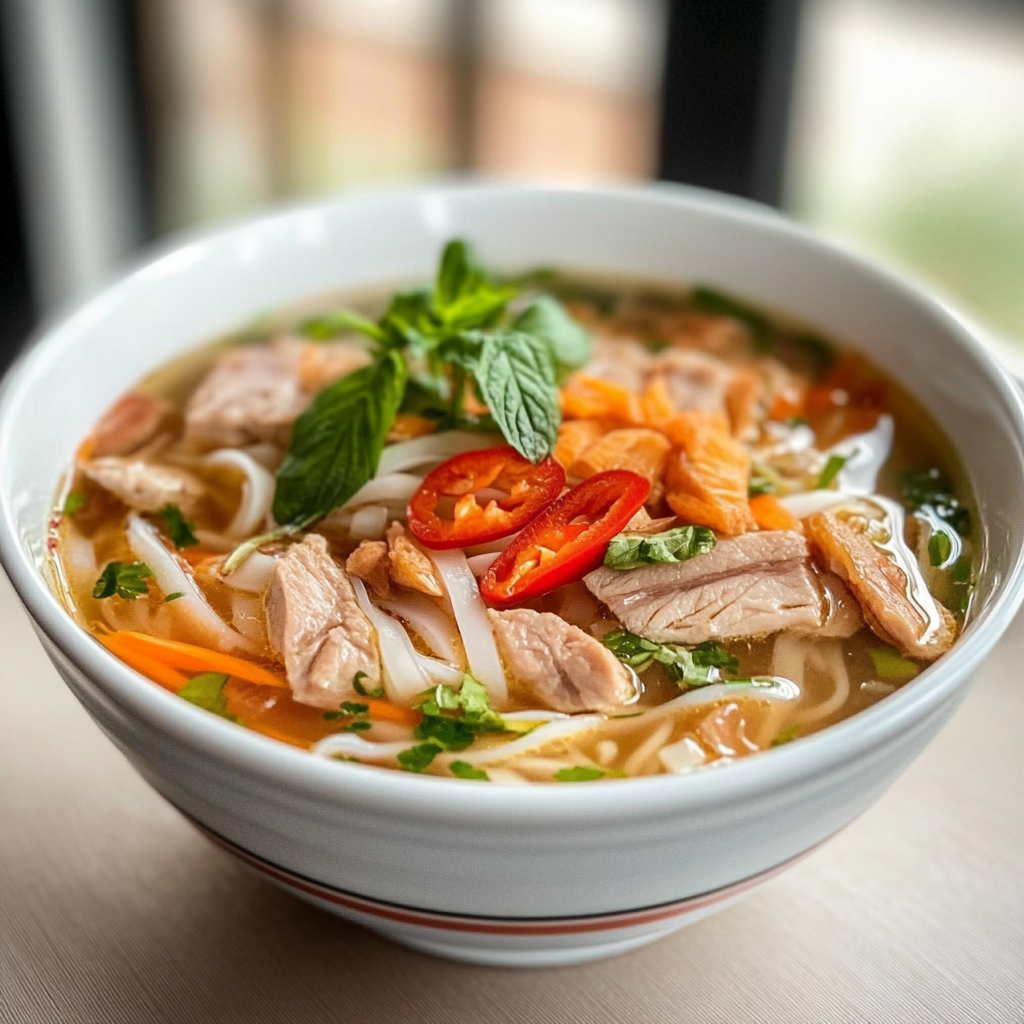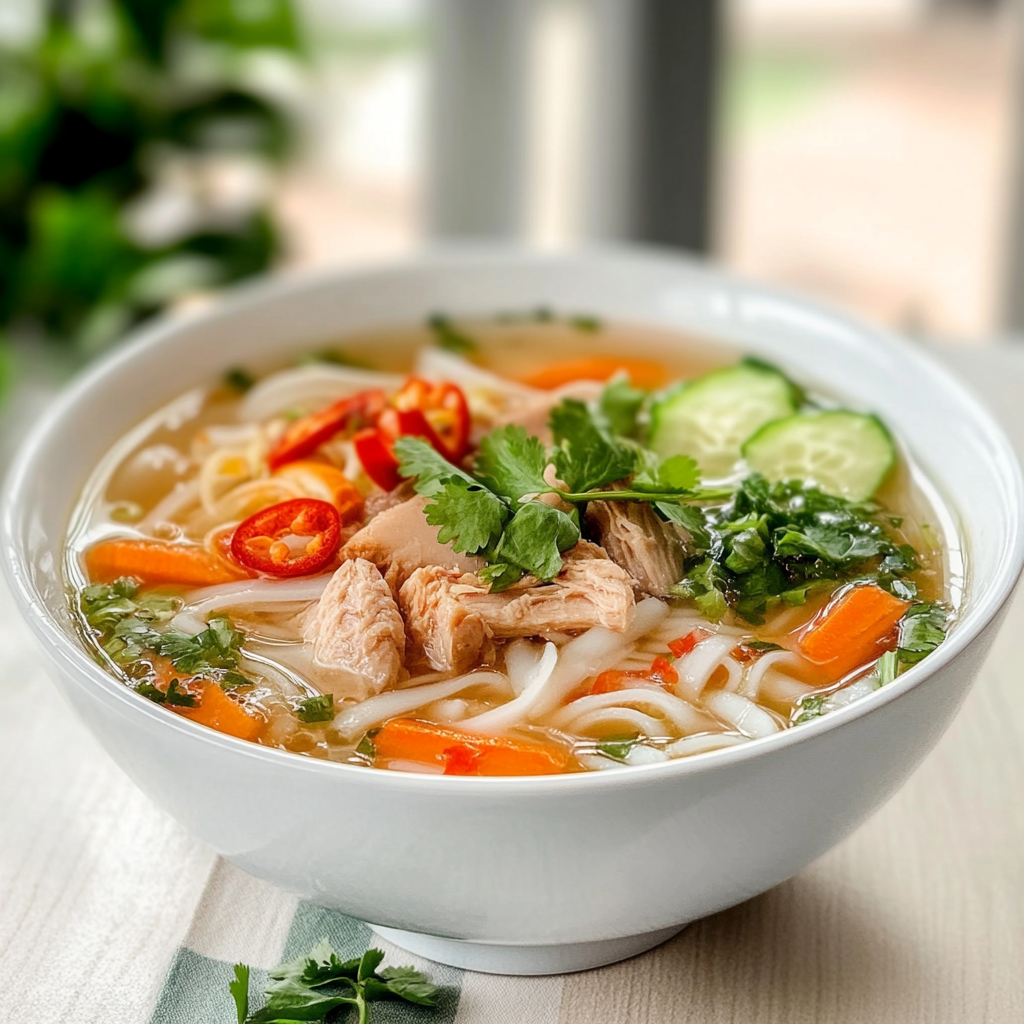Have you ever tasted a dish that instantly transports you to another place? Vietnamese noodle soup, known as pho, does just that. With its incredibly fragrant broth, tender noodles, and an array of fresh toppings, each bowl offers a delightful fusion of flavors that dance on your palate.
This beloved dish is not just about sustenance; it’s a celebration of culture and tradition. Whether enjoyed on a chilly evening or shared among friends during special gatherings, this aromatic soup brings warmth and comfort. Imagine savoring the depth of spices alongside the freshness of herbs—it’s a culinary experience you won’t want to miss. Join me in uncovering how to create your own bowl of joy right at home.
Why You’ll Love This Vietnamese Noodle Soup
- Flavor Explosion: This Vietnamese noodle soup features a rich broth infused with star anise, cloves, and ginger that creates an unforgettable flavor profile.
- Customizable Ingredients: You can adjust the toppings based on personal preferences—add bean sprouts, fresh basil, or jalapeños for extra flair.
- Quick Preparation: With simple steps and readily available ingredients, you can whip up this comforting meal in under an hour.

Ingredients for Vietnamese Noodle Soup
Here’s what you’ll need to make this delicious dish:
- Beef Bones: Choose marrow bones for a rich flavor; they are essential for creating a deep broth.
- Beef Brisket: Use about 1 pound; it adds tenderness and heartiness to your soup.
- Rice Noodles: Flat rice noodles work best; about 8 ounces will do for four servings.
- Fresh Herbs: Gather basil, cilantro, and mint to garnish; they enhance the dish’s aroma and taste.
For the Broth:
- Onion: Char one large onion for sweetness and depth in your broth.
- Ginger: A thumb-sized piece adds warmth; slice it to release maximum flavor.
The full ingredients list, including measurements, is provided in the recipe card directly below.
How to Make Vietnamese Noodle Soup
Follow these simple steps to prepare this delicious dish:
Step 1: Prepare the Broth
Begin by roasting the beef bones at 400°F (200°C) for about 30 minutes until browned. This step enhances the flavor significantly.
Step 2: Simmer with Aromatics
In a large pot filled with water, add roasted bones along with charred onion and ginger. Simmer on low heat for at least two hours while skimming off impurities.
Step 3: Add Spices
After two hours, introduce spices like star anise and cloves into the pot. Let them steep in the broth for an additional hour for maximum flavor infusion.
Step 4: Cook the Noodles
While the broth simmers, cook rice noodles according to package instructions—usually about five minutes in boiling water until tender.
Step 5: Assemble Your Bowl
Once done cooking the noodles and broth is ready, strain it into another pot. Place cooked noodles in bowls and pour hot broth over them.
Step 6: Garnish and Serve
Top each bowl with fresh herbs like basil and cilantro. Serve with lime wedges on the side for that refreshing twist.
Transfer to plates and drizzle with sauce for the perfect finishing touch.
Tips and Tricks
Here are some helpful tips to ensure the best results for your dish:
- Use Fresh Ingredients: Fresh herbs make a significant difference in taste; don’t skip on them!
- Adjust Spice Levels: Feel free to modify spice quantities based on your heat preference—add chili peppers if you like it spicy.
- Store Broth Properly: Leftover broth can be stored in airtight containers for up to three days; it tastes even better as flavors meld together over time.
Mistakes to avoid
- Using Low-Quality Ingredients: One of the most common mistakes when making Vietnamese noodle soup is opting for low-quality ingredients. Fresh herbs, high-quality meats, and authentic noodles are essential for achieving the true flavors of this dish. When you use subpar ingredients, the taste suffers significantly. Always choose fresh vegetables and authentic fish sauce to elevate your soup’s flavor.
- Skipping the Broth Preparation: Many people overlook the importance of a well-prepared broth in Vietnamese noodle soup. The broth should simmer for several hours to extract maximum flavor from bones and spices. Rushing this process results in a bland soup that lacks depth. Invest time in making a rich and aromatic broth; it is the heart of your dish.
- Overcooking the Noodles: Overcooked noodles can ruin your Vietnamese noodle soup experience. It’s crucial to cook the noodles just until they are al dente. If you leave them in hot broth too long, they will become mushy and lose their texture. To maintain that perfect bite, cook the noodles separately and add them just before serving.
- Neglecting the Toppings: Toppings play a vital role in enhancing the flavor profile of Vietnamese noodle soup. Common toppings include fresh herbs, bean sprouts, lime wedges, and sliced chilies. Failing to provide these garnishes can lead to an unbalanced dish that lacks freshness and brightness. Always prepare a variety of toppings for guests to customize their bowls.
- Ignoring Regional Variations: Vietnamese noodle soup has various regional variations that offer unique flavors and ingredients. Ignoring these differences can prevent you from fully appreciating this dish’s diversity. Explore recipes from different regions like Hanoi or Ho Chi Minh City to discover new tastes and styles that can enhance your cooking.
Serving Suggestions
This Vietnamese Noodle Soup is versatile and pairs wonderfully with:
- Fresh Herbs: Adding fresh herbs such as basil, cilantro, and mint enhances the flavor profile of the soup. These herbs not only provide a burst of freshness but also elevate the dish’s aroma.
- Sides of Lime and Chili: Serve lime wedges and sliced chili peppers on the side for an extra kick. Squeezing lime juice over the soup brightens the flavors, while chilies add heat according to your preference.
- Spring Rolls: Pairing your Vietnamese Noodle Soup with crispy spring rolls makes for a satisfying meal. The crunch of the rolls complements the soft noodles and savory broth in a delightful way.
FAQs
What is Vietnamese Noodle Soup made of?
Vietnamese Noodle Soup consists primarily of rice noodles, broth, and various meats or vegetables. The broth is often made by simmering beef or chicken bones with spices like star anise, cinnamon, and cloves to create a rich flavor. Fresh herbs, bean sprouts, lime, and chili are typically added just before serving to enhance taste. Each region in Vietnam has its own variation, making this dish unique across different locales.
How can I make vegetarian Vietnamese Noodle Soup?
To create a vegetarian version of Vietnamese Noodle Soup, start by using vegetable broth instead of meat-based broth. You can add tofu for protein and include a variety of vegetables such as bok choy, mushrooms, and carrots for texture. Seasoning with soy sauce and fresh herbs will help replicate the authentic flavors found in traditional recipes.
Can I freeze leftover Vietnamese Noodle Soup?
Freezing leftover Vietnamese Noodle Soup is possible but requires some caution. It’s best to freeze only the broth and noodles separately to maintain their texture. When reheating, add fresh herbs and toppings to revitalize the dish. Avoid freezing any garnishes like lime or bean sprouts until you are ready to serve.
How long does it take to prepare Vietnamese Noodle Soup?
Preparing Vietnamese Noodle Soup can take about 1 hour if you have all ingredients ready. If you’re making the broth from scratch, it may take longer due to simmering time needed for full flavor extraction. However, using pre-made broth can significantly reduce preparation time while still yielding delicious results.
Conclusion for Vietnamese Noodle Soup
Vietnamese Noodle Soup is a flavorful dish that showcases vibrant ingredients and aromatic spices. From its hearty broth to its delicate rice noodles, this soup offers a satisfying meal any time of year. Remember to explore various serving suggestions like adding fresh herbs or pairing it with sides like spring rolls to enhance your dining experience. Whether you prefer meat-based or vegetarian versions, each bowl allows for creativity while staying true to its roots in Vietnamese cuisine. Enjoy making this comforting dish at home for family gatherings or cozy nights in!

